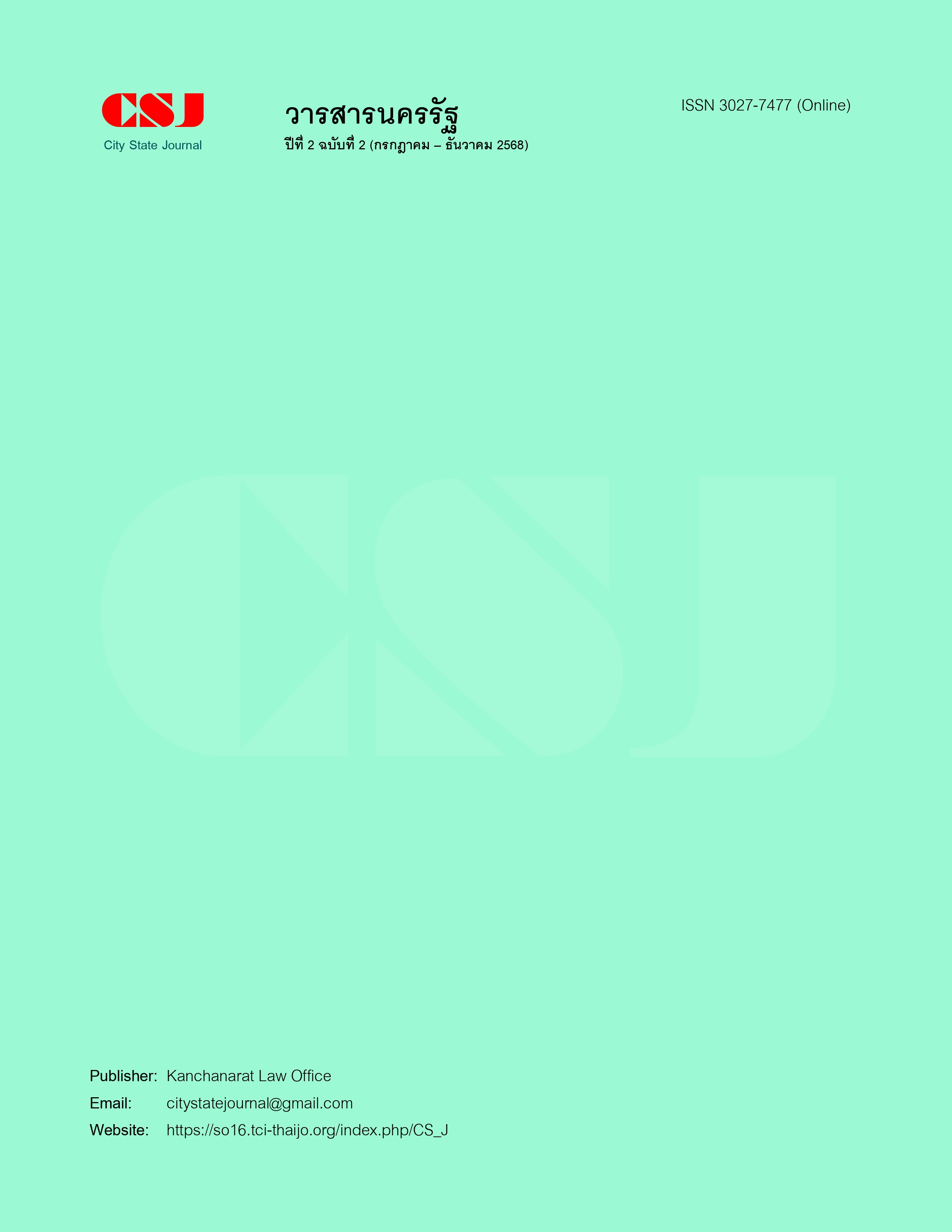The Relationship Between Digital Leadership of School Administrators and Core Competencies of Teachers Under the Secondary Educational Service Area Office Samutprakan
Main Article Content
Abstract
This research article aims to examines (1) the levels of digital leadership of school administrators under the Secondary Educational Service Area Office Samutprakan; studies (2) the levels of core competencies of teachers under the Secondary Educational Service Area Office Samutprakan. Finally, the research explores (3) the relationship between digital leadership of school administrators and core competencies of teachers under the Secondary Educational Service Area Office Samutprakan. The quantitative research approach was employed. The samples used in the research were 333 teachers in schools under the Secondary Educational Service Area Office Samutprakan in the academic year 2023. The research instrument was a 5-point rating scale questionnaire with the Item-Objective Congruence between 0.80-1.00 and reliability of the questionnaire in question stood at 0.97. The statistics used in data analysis were frequency, percentage, mean, standard deviation, and Pearson’s product-moment correlation coefficient. Findings are as follows: (1) The digital leadership of school administrators under the Secondary Educational Service Area Office Samutprakan overall and for all aspects were expressed at a high level. (2) The core competencies of teachers under the Secondary Educational Service Area Office Samutprakan overall and for all aspects were expressed at a high level. (3) Overall and for all aspects, the digital leadership of school administrators positively correlated with the core competencies of teachers under the Secondary Educational Service Area Office Samutprakan at the statistically significant level of .01.
Article Details

This work is licensed under a Creative Commons Attribution-NonCommercial-NoDerivatives 4.0 International License.
The article published in the journal is the opinion and responsibility of the authors. Not related to Kanchanarat Law Office.
References
จันทนา แสนสุข. (2559). ภาวะผู้นํา (พิมพ์ครั้งที่ 3). ทริปเพิ้ล กรุ๊ป.
ณัฏฐิตา สงค์แก้ว. (2565). ภาวะผู้นําดิจิทัลของผู้บริหารสถานศึกษาสังกัดสำนักงานเขตพื้นที่การศึกษาประถมศึกษานครศรีธรรมราช เขต 1. วารสารสมาคมนักวิจัย, 27(3), 49-64.
ดาวรุวรรณ ถวิลการ. (2564). ภาวะผู้นำดิจิทัล. มหาวิทยาลัยขอนแก่น, คณะศึกษาศาสตร์.
พนธกานต์ นุฤทธิ์มนตรี, อาทิตย์ ฉัตรชัยพลรัตน์ และกุหลาบ ปุริสาร. (2565). ภาวะผู้นำทางวิชาการของผู้บริหารในยุคดิจิทัล. วารสารวิทยาลัยบัณฑิตเอเซีย, 12(4), 174-185.
มนัสพงษ์ เก่งฉลาด. (2566). ความสัมพันธ์ระหว่างภาวะผู้นำยุคดิจิทัลของผู้บริหารสถานศึกษากับสมรรถนะหลักของครูในสถานศึกษา สังกัดสำนักงานเขตพื้นที่การศึกษามัธยมศึกษากรุงเทพมหานคร เขต 1. การศึกษาค้นคว้าด้วยตนเองการศึกษามหาบัณฑิต, มหาวิทยาลัยพะเยา.
มูฮำหมัดรุซลัน ลือบากะลูติง และนิรันดร์ จุลทรัพย์. (2565). ภาวะผู้นำดิจิทัลของผู้บริหารสถานศึกษา สังกัดสำนักงานเขตพื้นที่การศึกษามัธยมศึกษาตรัง กระบี่. ใน การประชุมหาดใหญ่วิชาการระดับชาติและนานาชาติ ครั้งที่ 13 (หน้า 1935-1946), มหาวิทยาลัยหาดใหญ่.
รุจาภรณ์ ลักษณะดี. (2565). ภาวะผู้นำดิจิทัลของผู้บริหารสถานศึกษาในสหวิทยาเขตบ้านบึง 1 สังกัดสำนักงานเขตพื้นที่การศึกษาประถมศึกษาชลบุรี เขต 1. การค้นคว้าอิสระศึกษาศาสตรมหาบัณฑิต (การบริหารการศึกษา), มหาวิทยาลัยเกริก.
ลลิตา สมใจ. (2565). ความสัมพันธ์ระหว่างภาวะผู้นำในยุคดิจิทัลของผู้บริหารสถานศึกษากับประสิทธิผลของสถานศึกษา สังกัดสำนักงานเขตพื้นที่การศึกษาประถมศึกษาเชียงราย เขต 1. การศึกษาค้นคว้าด้วยตนเองการศึกษามหาบัณฑิต, มหาวิทยาลัยพะเยา.
วราภรณ์ พวงสำเภา และชนมณี ศิลานุกิจ. (2566). ภาวะผู้นำดิจิทัลของผู้บริหารสถานศึกษา โรงเรียนในกลุ่มกรุงเทพตะวันออก สังกัดกรุงเทพมหานคร. วารสารสหวิทยาการและการจัดการร่วมสมัย, 2(1), 1-14.
สุภวัช เชาวน์เกษม, วิสุทธิ์ วิจิตรพัชราภรณ์ และสุดารัตน์ สารสว่าง. (2563). ความสัมพันธ์ระหว่างภาวะผู้นำยุคดิจิทัลของผู้บริหารสถานศึกษากับประสิทธิผลโรงเรียนสังกัดสำนักงานเขตพื้นที่การศึกษามัธยมศึกษา เขต 1. วารสารการบริหารและนวัตกรรมการศึกษา, 13(3), 85-99.
สำนักงานคณะกรรมการการศึกษาขั้นพื้นฐาน. (2553). คู่มือประเมินสมรรถนะครูู (ฉบับปรับปรุง). ผู้แต่ง.
สำนักงานคณะกรรมการพัฒนาการเศรษฐกิจและสังคมแห่งชาติ. (2559). แผนพัฒนาเศรษฐกิจและสังคมแห่งชาติ ฉบับที่สิบสอง (พ.ศ. 2560-2564). ผู้แต่ง.
สำนักงานเลขาธิการสภาการศึกษา. (2560). แผนการศึกษาแห่งชาติ พ.ศ. 2560-2579. ผู้แต่ง.
อัจฉรา นิยมาภา. (2561). การพัฒนาตัวชี้วัดสมรรถนะภาวะผู้นำทางวิชาการของผู้บริหารสถานศึกษาในการจัดการเรียนรู้ของผู้เรียนในศตวรรษที่ 21 สังกัดกรุงเทพมหานคร. สักทอง: วารสารมนุษยศาสตร์และสังคมศาสตร์, 24(1), 50-63.
Cohen, L., Manion, L., & Morrison, K. (2018). Research methods in education (8th ed.). Routledge.
Cronbach, L. J. (1951). Coefficient alpha and the internal structure of tests. Psychometrika, 16(3), 297-334.
Frost, J. (2019). Introduction to statistics: An intuitive guide for analyzing data and unlocking discoveries. Statistics by Jim Publishing.
Likert, R. (1932). A technique for the measurement of attitudes. Archives of Psychology, 22(140), 5-55.
Lindner, J. R., & Lindner, N. J. (2024). Interpreting Likert-type scales, summated scales, unidimensional scales, and attitudinal scales: I neither agree nor disagree, Likert or not. Advancements in Agricultural Development, 5(2), 152-163.
McClelland, D. C. (1973). Testing for competence rather than for “intelligence.” American Psychologist, 28(1), 1-14.
Pearson, K. (1909). Determination of the coefficient of correlation. Science, 30(757), 23-25.
Sheninger, E. (2019). Digital leadership: Changing paradigms for changing times (2nd ed.). Corwin.
Sujaya, K. (2022). Digital leadership competencies to improve the quality of high schools in Tasikmalaya city in the post-pandemic Covid-19. Eurasian Journal of Educational Research, 100, 222-235.
Sunu, I. G. K. A. (2022). The impact of digital leadership on teachers’ acceptance and use of digital technologies. Jurnal Mimbar IlmuVolume, 27(2), 311-320.

